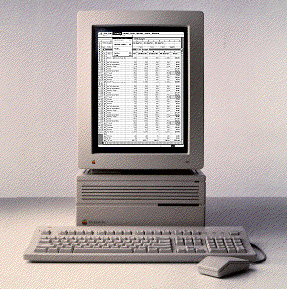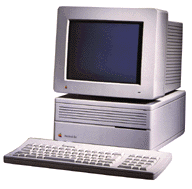History of computer design: Macintosh IIcx
4-frogdesign || 5-Corporate focus || Conclusion || Bibliography & links
![]()
![]()
 "Corporate" Snow White established the
appearance of the Macintosh throughout the late 1980s.
However, with frogdesign no longer used by Apple, the design
language was adapted instead by Apple's own designers to new
products. The first of such "Snow White 'skin jobs'" was by
Gavin Ivester, an apprentice working at Apple while
finishing an industrial design degree at San Jose State
University. He was the youngest industrial designer ever to
complete a shipped product
(Kunkel, 61). This
expresses the fallen emphasis on design at Apple during the
years that products were guided by Jean-Louis Gassée,
but also indicates the resilience and clarity of the Snow
White language. Apple could easily follow the guidelines set
by frogdesign until the use of Snow White became stale or
filtered into other computer companies' products.
"Corporate" Snow White established the
appearance of the Macintosh throughout the late 1980s.
However, with frogdesign no longer used by Apple, the design
language was adapted instead by Apple's own designers to new
products. The first of such "Snow White 'skin jobs'" was by
Gavin Ivester, an apprentice working at Apple while
finishing an industrial design degree at San Jose State
University. He was the youngest industrial designer ever to
complete a shipped product
(Kunkel, 61). This
expresses the fallen emphasis on design at Apple during the
years that products were guided by Jean-Louis Gassée,
but also indicates the resilience and clarity of the Snow
White language. Apple could easily follow the guidelines set
by frogdesign until the use of Snow White became stale or
filtered into other computer companies' products.
The Macintosh IIcx design was
completed by Ivester in 1987, though the product did not
ship until early 1989. The IIcx is in essence a compact
version of the Macintosh II. Having only three rather than
six expansion slots and room for only one floppy, it is far
narrower than its predecessor (see
technical
specifications). It has a less formal appearance than the Macintosh II, an effect generated
largely by the addition of five Snow White lines between the
break in the bezel where the case comes apart and the strip
containing the floppy slot. The recessed base with its
vertical lines are missing, replaced instead by a single
line wrapping around to the back of the case, mirroring in
its placement the break less than an inch from the top.
than the Macintosh II, an effect generated
largely by the addition of five Snow White lines between the
break in the bezel where the case comes apart and the strip
containing the floppy slot. The recessed base with its
vertical lines are missing, replaced instead by a single
line wrapping around to the back of the case, mirroring in
its placement the break less than an inch from the top.
The symmetry used on the case visually reinforces its ability to rest both on its bottom and on its side. The idea for designing a computer that could be turned onto its side was suggested, not by a designer, but by CEO John Sculley, who found he needed more desk space. The IIcx came with little rubber feet that could be removed from the bottom of the case and placed on its side for this first use of a "minitower" design. Its case was used again in September 1989 for the IIci, marketed very successfully towards graphic design professionals (Kunkel, 61-2).
Home || Introduction || Historiography || 1-Cottage industry || 2-Emerging standards || 3-Macintosh
4-frogdesign || 5-Corporate focus || Conclusion || Bibliography & links







.jpg)








